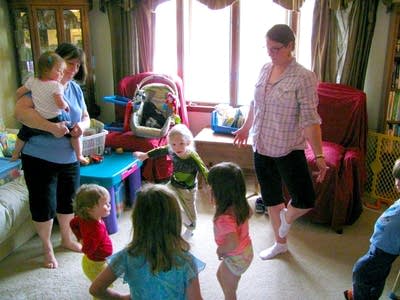Achievement gap shows up in day care
Go Deeper.
Create an account or log in to save stories.
Like this?
Thanks for liking this story! We have added it to a list of your favorite stories.

In Minnesota, parents are spending more on daycare than on college. According to the new Child Care Aware Report, average tuition and fees for a public college in Minnesota run about $10,000, while it takes nearly $14,000 to buy full-time care for an infant.
That makes Minnesota the third-most expensive state for child care in the country. And we're not alone. Infant day care costs more than college in 30 other states and the District of Columbia.
On Monday we talked about the issue with Ann McCully, head of Child Care Aware of Minnesota, and Katie Hamm, director of early childhood policy at the Center for American Progress. Some highlights of that conversation:
Hamm on the roots of the achievement gap:
We see differences in children in terms of where they are developmentally and cognitively extremely early. As early as the toddler years. And that gap widens when children enter kindergarten, and by middle school and high school it's very large. I think access to early childhood education is the first place to start; we call it the school-readiness gap that begins before children even set foot inside a classroom. We've talked about the importance of brain development; by the time you're three years old, your brain is 90 percent developed. Your language is really important in the first few years. There's a study that looked at the words that kids hear, and found that low-income children hear 30 million fewer words by the time they're 4 years old. What we really see in the first few years are the beginnings of the achievement gap.
McCully on the difference between child care and early ed:
Increasingly, we are trying to think about child care as equal to early education. If a good-quality child care program is doing it right, it shouldn't look different ... they are synonymous, in our world, at least in the work we're trying to do. We've come a long way from the days of what people would consider typical custodial care. ... We are trying to work with providers to recognize that what they're doing at that critical time, when they're with those young children, is really — in partnership with the parents, of course — focusing on that brain architecture of the child. They have so much influence on the children's development while they're in their care that we really want them to be thinking about ... the impact they're having. The kinds of toys, the kinds of curriculum, how they're assessing the progress of that child, all of that's really important.
Hamm on the costs of child care:
We know that high-quality infant care is expensive, and $12,000, $15,000 a year is approximately what it costs to do good-quality care. When you think about families, particularly low-income families, it's really more than they can afford. So parents are then in a position where they have to think about quitting their job or reducing their hours, or finding care with a relative or a friend or anyone who happens to be home that might not be providing the best quality care.
McCully on the need for more public funding:
We are at a breaking point between what parents can actually pay out of pocket and what the true costs are of child care and early education. And what we really need to do, if we believe as I think we increasingly do that that's an important investment in our earliest years, then we need to be putting state and federal dollars into that more heavily.
Turn Up Your Support
MPR News helps you turn down the noise and build shared understanding. Turn up your support for this public resource and keep trusted journalism accessible to all.
Dear reader,
Political debates with family or friends can get heated. But what if there was a way to handle them better?
You can learn how to have civil political conversations with our new e-book!
Download our free e-book, Talking Sense: Have Hard Political Conversations, Better, and learn how to talk without the tension.





